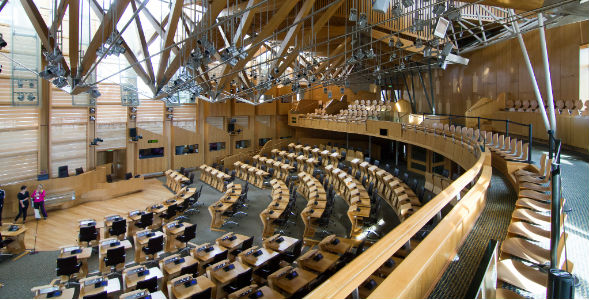On the ballot: how electoral procedures shape the work of Members of the Scottish Parliament
The electoral system by which members of parliament are elected shapes how legislators perceive their roles. Furthermore, write David C.W. Parker and Caitlyn M. Richter, in the case of the Scottish Parliament, both the electoral system and the change implemented prior to the 2007 election, whereby candidate names were removed from party-list ballots, have an impact on how Members of the Scottish Parliament spend their time and resources.

Scottish Parliament. Picture: Jun, via a CC BY-SA 2.0 licence
When one takes a public tour of the Scottish Parliament, comparisons inevitably are made by the guides to the Palace of Westminster and the House of Commons’ debating chamber. The physical structure of the chamber at Holyrood, where legislators sit in a semi-circle as opposed to the government sitting across from the opposition, was purposefully designed by the architects to encourage a less adversarial, more cooperative governing style. So it is said, at least. Whether more productivity and collegiality follows in this case is an open question, but it goes without saying that parliamentary spaces affect legislative outcomes and the representational choices parliamentarians make.
In much the same way, how parliamentarians are selected to serve shapes powerfully how they conceive of their jobs and the types of activities in which they engage. Winner-takes-all, First Past the Post, single-member districts encourage the development of a personal vote and more attention by members to constituency service activities. Multi-member districts where parties maintain access to the ballot, conversely, encourage strong party discipline and less attention by parliamentarians to constituent casework. Given that some Members of the Scottish Parliament (MSPs) are chosen in single-member constituencies whilst others are chosen to represent multi-member regions, does this bifurcated arrangement have consequences for the types of representational activities MSPs undertake? That’s the question that Caitlyn Richter and I examine in a piece recently published in the British Journal of Politics and International Relations. We found, in short, that balloting arrangements and how legislators are selected have clear consequences for the representational roles they chose to adopt as measured by what they do within the chamber and how they allocate their representational allowances.
In the Scottish Parliament, 73 MSPs represent constituencies, have their names listed on the ballot papers and are directly selected by voters in plurality elections. The remaining 56 MSPs represent eight regions, with seven members allotted to each region. When Scots go to the polls, they cast one vote for a constituency MSP, and a second for a political party. Depending on how well each party does in the region and in the constituency elections, parties are then allotted a certain proportion of the regional seats – with parties filling their seat quota from a closed list. Before 2007, the names of the candidates running for these regional seats (and their ranking on the lists) were printed on the ballot papers. Since 2007, however, only the party names have been listed.
It is well-known that MSPs perceive their roles differently depending on whether they are a regional or constituency MSPs from self-reported surveys on committee and constituency work. And we also know that regional MSPs attempt to build a personal vote and pay more attention to particular constituencies within their regions by the careful location of their home offices, with an eye toward contesting a constituency seat in future elections. But do the perceptions of MSPs match the actual choices made by them in their parliamentary duties – beyond where they locate their offices? That question remained unanswered.
The amount of time MSPs have during each parliamentary session is limited, so they have to make careful choices as to how they allocate their time and representational resources. We expect that constituency member MSPs concentrate more on casework activities given their need to cultivate a personal connection to voters back home, but regional members prefer attending to policy-related duties and advancing the party’s collective interest in the chamber. These choices are the end product of institutional arrangements. Regional members behave so because their position on the party-list ballot is ultimately left to party selectorates, not constituents writ large. Constituency MPSs, by contrast, are directly accountable to constituents, so casework is a more appealing foundation upon which to build a personal vote.
Furthermore, we expect differences between members in terms of their representational behaviour to be clearer after the 2003 election, since when regional members have not been listed on ballot papers. The removal of regional names should alter the usefulness of the personal vote for regional members and the type of representational activities yielding the greatest benefit in the eyes of party activists and members, who choose the slate and rankings of regional candidates.
To test our expectations, we developed three indicators of legislative activity (members’ bills sponsored, parliamentary motions made, rebellions on floor votes) and one measure of constituency service (pounds spent on surgery advertisements) gathered from the Scottish Parliament’s website. In the analysis, we control for a number of other institutional, constituency need and individual-level variables affecting the legislative output of MSPs.
We find that both Mixed Member Proportional representation and whether regional candidate names are listed on the ballot have consequences for the representational choices made by MSPs while at Holyrood (see Figure 1). Constituency members gain the most from crafting a personal vote, and how they engage in the legislative process indicates that they behave accordingly. They spend more on surgery advertisements than regional members (£3491 compared to £2476 on average), and are less likely to write a member’s bill or make motions on the floor of the Scottish Parliament. The behaviour of regional members also evolved in response to the ballot changes. When they were listed on the ballot, regional MSPs rebelled more often and sponsored more members’ bills, both relatively costless activities to communicate a personal vote to constituents back in the region and in constituencies they may contest in future elections. After regional names were dropped from the ballot papers, it is clear regional MSPs started to prefer advancing their party’s interests and brand by making more motions in the chamber and voting with the whip.

Probability estimates of MSP introducing one or more members’ bills and MSP rebelling or making motions at one standard deviation above the mean.
It has long been accepted that it is harder and perhaps less valuable for parliamentarians in the United Kingdom to spend resources and time on activities tied to establishing a personal vote given the relative strength of the British party system both among the electorate and in the nomination process. This is as true in Scotland as elsewhere in Great Britain. Nevertheless, it is also a truism that parliamentarians are risk adverse and ‘run scared’, to paraphrase Anthony King’s (1997) characterisation of American legislators. They want to maximise their prospects of reselection and re-election. Even though the representational resources available for legislators in the Scottish Parliament are relatively scant compared to members of the US House or Senate, it is clear that MSPs carefully husband those resources and the time they spend at Holyrood to project particular representational styles to constituents and party selectorates. And, most importantly, the key driver of those representational choices are the institutional structures embedded in the fabric of MMP and balloting arrangements selected by electoral commissions.
This article represents the views of the authors and not those of Democratic Audit. It draws on: ‘Back from Holyrood: How mixed-member proportional representation and ballot structure shape the personal vote’, by David C.W, Parker and Caitlyn M. Richter, published in The British Journal of Politics and International Relations.
About the authors
 David C.W. Parker is an associate professor of political science at Montana State University in Bozeman, Montana and recently authored Battle for the Big Sky: Representation and the Politics of Place in the Race for the U.S Senate. He studies representation and executive oversight in the U.S. and British political systems.
David C.W. Parker is an associate professor of political science at Montana State University in Bozeman, Montana and recently authored Battle for the Big Sky: Representation and the Politics of Place in the Race for the U.S Senate. He studies representation and executive oversight in the U.S. and British political systems.
 Caitlyn M. Richter graduated from Montana State University in 2017 with a B.A. in political science, a minor in sociology, and earned a degree with distinction from the University Honors College. She currently serves as the AmeriCorps service member at the American Red Cross through the Washington Service Corps in Wenatchee, Washington, where she provides disaster preparedness knowledge and skills to the community.
Caitlyn M. Richter graduated from Montana State University in 2017 with a B.A. in political science, a minor in sociology, and earned a degree with distinction from the University Honors College. She currently serves as the AmeriCorps service member at the American Red Cross through the Washington Service Corps in Wenatchee, Washington, where she provides disaster preparedness knowledge and skills to the community.





 Democratic Audit's core funding is provided by the Joseph Rowntree Charitable Trust. Additional funding is provided by the London School of Economics.
Democratic Audit's core funding is provided by the Joseph Rowntree Charitable Trust. Additional funding is provided by the London School of Economics.
[…] blog was originally posted on Democratic Audit, and is cross-posted with […]